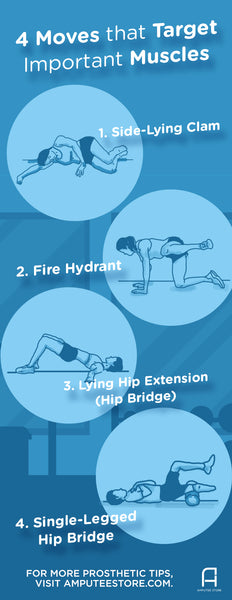4 Moves for Amputees that Target Important Muscles
It's quite easy to neglect certain muscles in your body when your lifestyle changes and you find yourself not moving around as much due to amputation. Sitting for long periods of time or having poor posture can cause these muscles to disengage—a condition more commonly known as "gluteal amnesia".

As an amputee, it's important to continue exercising to keep important muscles in good shape. While it’s also important to work out the chest, arms, and abs, we need to remember a certain set of muscles that are primarily responsible for stable movement—the posterior chain.
What is the posterior chain?
The posterior chain is a series of muscles along the back of your body from your spine down to the heels. Your glutes (butt muscles) and hamstrings are two vital muscles that facilitate movement. They work together to make sure that force and movement are possible.Glutes are responsible for hip extension and pelvic stability. Hip extension allows us to stand upright, while pelvic stability gives us balance and control of our center. To avoid issues such as tight hips or lower-back pain, strengthening your glutes is crucial.
Here are some exercises you can do at home to get your smaller muscles up and running. All you need is a mat for extra comfort, and possibly a resistance band once your body permits more advanced movements.
Side-lying clam
- Difficulty: Low
- Starting position: Lie on your side with your needs bent and stacked.
- Exercise: Raise your top knee towards the ceiling, then lower it back to your initial position.
- Repeat for: 2 sets of 12-15 reps. If you wish to challenge yourself, wrap a resistance band around your knees.
Fire hydrant
- Difficulty: Medium to High
- Starting position: Begin on your hands and knees and make sure your back and neck are straight. Place your hands directly under your shoulders and your knees directly beneath your hips.
- Exercise: Slowly lift your leg out to the side until it's parallel to the ground. Keep your knee and ankle bent at a 90-degree angle. Hold for a few seconds then return to your starting position.
- Repeat for: 8 times with 3 sets on each side.
Lying Hip Extension (Hip Bridge)
- Difficulty: Low
- Starting position: Lie face up with your hands extended at your side and your knees bent with your feet flat on the ground.
- Exercise: Brace your stomach and use your heels to raise your hips toward the ceiling. Squeeze your glutes and keep your spine straight.
Single-legged hip bridge
- Difficulty: Low to Medium; Add a rotational stability component for more challenge
- Starting position: Lie face up with your hands extended on each side. Bend one knee with your foot flat on the ground and keep your other leg straight.
- Exercise: Use your heel on the ground to raise your hips up, keeping your stomach braced and tight. Make sure your extended leg is straight as possible along with your spine. Continue to squeeze your glutes and keep your back straight without tilting your pelvis.
Before you begin any of these 4 home exercises, consult with your prosthetist or physical therapist to make sure your body is ready and equipped. They may also recommend other work out options that may suit your amputation type and level.
Please comment if you have other suggestions for exercises to improve walking.











































































